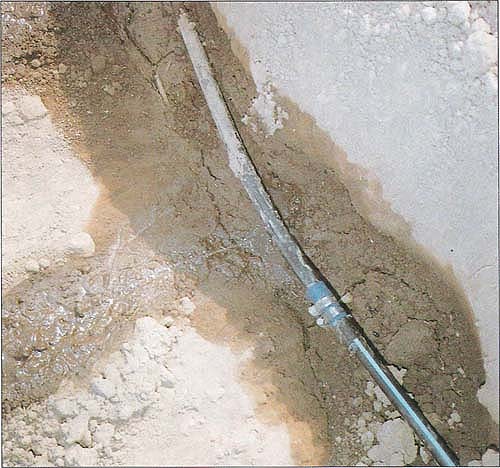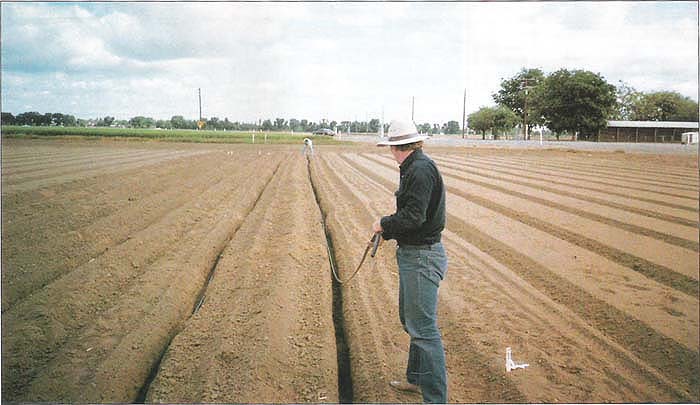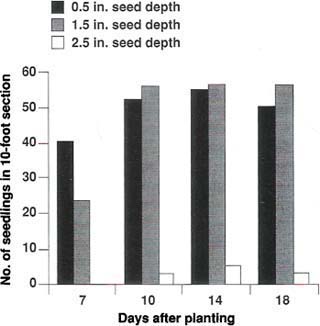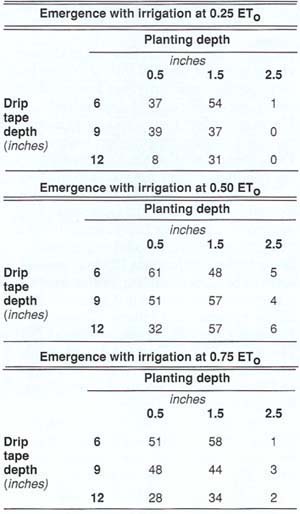All Issues
Subsurface drip irrigation of tomatoes: Drip system design, management promote seed emergence
Publication Information
California Agriculture 45(6):21-23.
Published November 01, 1991
PDF | Citation | Permissions
Abstract
Subsurface drip irrigation has a number of potential advantages over conventional surface irrigation; it curtails weed growth and reduces water loss due to high irrigation uniformity. Depending on a system's design and management, however, it may not always provide adequate soil moisture to germinate the crop seed. This study demonstrates that acceptable levels of seed emergence can be obtained in processing tomatoes using subsurface drip irrigation in clay-loam soil.
Full text
As concerns grow over limited water supplies, interest in the use of drip irrigation systems is increasing. The use of drip irrigation is already prevalent on many permanent crops, such as trees and vines. It is less common on annual row crops, but both surface and subsurface drip irrigation are used on vegetable crops, and subsurface drip irrigation is commonly used on strawberries. Subsurface drip irrigation has been used on cotton and processing tomatoes to a limited extent.
Subsurface drip irrigation has numerous potential advantages over surface irrigation. Water is applied in a uniform manner, allowing nearly all portions of the field to be irrigated efficiently; irrigation water and injected fertilizers are delivered directly to the root zone; the field surface remains dry if the subsurface drip systems are buried at depths of 9 inches or below, which allows both easy access for equipment and reduces annual weed growth; and frequent, small irrigations can be made, maintaining soil moisture conditions at a level favorable to plant growth.
Subsurface drip systems also have disadvantages. High initial cost, leaks and clogging problems, and other management and maintenance requirements are all disadvantages in using subsurface drip irrigation. Leaks and clogging are a particular concern, since the system is buried and clogging is not visible as it would be in a drip system installed on the soil surface.
An additional concern about using subsurface drip in row crops is the ability of the system to provide soil moisture conditions adequate to germinate the crop seed. A small number of commercial growers are currently irrigating processing tomatoes with subsurface drip systems, but in many cases tomato stands are first established by sprinkler irrigation. This necessitates the use of two, capital-intensive irrigation systems to produce the crop.
To investigate the use of subsurface drip systems to germinate processing tomato seed, a field experiment at UC Davis was performed during the summer of 1989.
Experiment design
Three major design and management factors of subsurface drip irrigation affect emergence: (1) depth of burial of the subsurface drip tape, (2) depth of seed placement and (3) irrigation frequency and amount during the germination period. Other soil condition factors (soil texture, soil structure, organic matter, content and initial soil moisture status) are also important.
Various burial depths of subsurface drip irrigation tape, ranging from only a few inches to as deep as 18 inches, have been advocated for use with row crops. The most common burial depth for processing tomatoes has been 8 to 10 inches. Identifying the optimal depth for drip tape placement is important. The drip tape must be placed deep enough to allow for soil surface cultivation, but close enough to the soil surface to provide adequate moisture for crop seed emergence. The surface wetting pattern is also affected by soil type and irrigation duration and frequency, which will be discussed below. In this field experiment, three subsurface drip burial depths were investigated in a Yolo clay-loam soil: 6, 9, and 12 inches. Bi-Wall drip irrigation tape (15 mil, 12 x 60 inch spacing) was placed in the center of each 60-inch spaced bed. Drip tape was thus located directly below the seed to deliver a flow rate of 0.4 gal/min/100 ft of drip tape.
Seed planting depth also plays a major role in emergence. Shallow planting depths can result in faster germination, but the newly germinated seedlings are susceptible to the soil surface drying out from evaporation. Deeper planting has the advantage of placing the seed in an adequate and more stable soil moisture environment, but has the possible disadvantage of delayed or absent emergence. Seed planting depths of 0.5 inch, 1.5 inches and 2.5 inches were investigated in this experiment.
Irrigation frequency and duration also play a major role in soil surface wetting and seed emergence. The subsurface drip system should operate long enough and frequently enough to ensure that the soil surface is wetted and remains moist. However, applying too much water may result in water losses due to deep percolation. Because subsurface drip is frequently used to increase irrigation efficiency, significant deep percolation during the germination period is not desirable.
We decided that a practical irrigation strategy for germination would be to operate the subsurface drip system until the soil surface above the tape (and seed) was visibly wetted. For the Yolo clay-loam soil in which this experiment was performed, approximately 1.4 inches of water was adequate to wet a 6- to 12-inch-wide strip on the soil surface above the buried drip lines in each plot. In coarser soils, a larger quantity of water may be required to adequately wet the beds.
Following the initial wetting, three irrigation-quantity treatments were imposed. Plots were irrigated daily in quantities equivalent to 0.25, 0.5 and 0.75 of reference evapotranspiration (ETo). A California Irrigation Management Information System (CIMIS) weather station, situated over a uniform grass and located within 1,500 feet of the experimental site, provided the daily ETo values. Different quantities of applied water were achieved by varying the irrigation system operating time. These daily irrigations were applied to replace soil moisture lost to evaporation and to ensure a moist soil surface for seedling germination and emergence.
Combining the three drip-tape burial depths (6, 9 and 12 inches), the three seed placement depths (0.5, 1.5 and 2.5 inches), and the three irrigation treatments (0.25, 0.50 and 0.75 ETo) resulted in 27 treatments. Each of these 27 treatments was replicated five times for a total of 135 randomized plots. Each plot consisted of a 60-inch-wide bed, 35 feet long.
Each of the plots were planted with tomatoes (Lycopersicon esculentum, Mill. CV EM 6203) using a precision planter at a rate of 10 seeds/ft, at the appropriate depth, on May 23, 1989. On May 26, the subsurface drip system was operated to apply 1.4 inches of water to wet the surface of the beds. On May 27, the three irrigation treatments (0.25, 0.50 and 0.75 ETo) were imposed on all plots.
Results and discussion
Emergence of the tomato seedlings began approximately 5 to 6 days following the first irrigation. The first count of seedling emergence was taken on June 2, 7 days after the first irrigation. A 10-foot section in the center of each 35-foot plot was delineated, and all seedling emergence counts were made in this 10-foot section. At a seeding rate of 10 seeds/ft, approximately 100 seeds were planted in the 10-foot monitored sections. Subsequent seedling counts were taken on June 5, 9, and 13.
Table 1 shows the average number of emerged seedlings for each of the 27 treatments on June 13. Data indicate that seeds placed at a depth of 2.5 inches emerged poorly regardless of water application or tape burial depth treatments. Seed placement at 2.5 inches appears to be too deep for proper emergence under even optimum soil moisture conditions.
Under light water application (0.25 ETo) and 6-inch drip tape burial depth, there was a significant (at 2% level) increase in seedling emergence resulting from seed placement at the 1.5-inch depth (54 seedlings/10 ft) versus the 0.5 inch depth (37 seedlings/10 ft). This difference, however, was not evident when the water application treatments were increased to 0.5 ETo or 0.75 ETo. This would indicate that increasing the daily irrigation amount tends to mask the effects of seed placement depth and drip tape burial depth. An obvious strategy for system operation would be to irrigate daily at the 0.5 ETo level, as a minimum.
Fig. 1. Seedling emergence per 10-foot section (100 seeds) versus days after planting for 0.5 ETo and 9-inch drip tubing burial depth treatments.
TABLE 1. Average number of emerged seedlings out of 100 seeds planted per 10-foot section, 18 days after initial irrigation
Table 1 and additional analysis of variance (ANOVA) calculations showed that seedling emergence was significantly reduced as the tape depth increased from 9 inches to 12 inches when seed placement was 0.5 inches. This was true for all irrigation treatments (0.25 ETo at 1% significance level, 0.5 ETo at 4% significance level, and 0.75 ETo at 2% significance level). These results are analogous to those described above and indicate that with subsurface drip burial depth of 12 inches, adequate surface- to near-surface moisture conditions for optimal seed emergence could not be maintained. Under coarsetextured soils, this effect may be even more pronounced.
Table 1 and ANOVA calculations indicate that for drip tape buried at the 12-inch level, seed placement at the 1.5-inch depth resulted in better emergence than at the 0.5-inch depth. This is not surprising because it is easier to maintain more favorable and more stable soil moisture conditions for emergence when the seed is not so near the soil surface. If the combination of 0.5-inch seed depth and 12-inch drip tape burial depth are to be used, increased daily irrigation amounts would be advisable for this soil type. It is possible, although not evaluated in this experiment, that increasing daily irrigations may mitigate this effect. Remember that such a strategy could result in increased deep percolation amounts.
Seed placement depth also impacts rate of germination. Figure 1 illustrates a typical relationship between seed emergence counts and time after irrigation was begun. Most rapid germination occurred at the 0.5-inch planting depth treatment as measured 7 days after irrigation began. By 10 days after initiation of irrigation, emergence counts between the 0.5-inch and 1.5-inch planting depth treatments no longer differed significantly.
Summary
The results of this experiment indicate that an acceptable stand of processing tomato seedlings can be achieved using subsurface drip irrigation in clay-loam soil. Seed placement depth of 2.5 inches was too deep to obtain acceptable emergence. Study results indicate-that daily irrigations during the emergence period of 0.5 ETo or greater, following an initial irrigation to wet the bed surface, gave the best results. Drip tape burial depths of 6 and 9 inches provided greater seedling emergence than a 12-inch burial depth.








